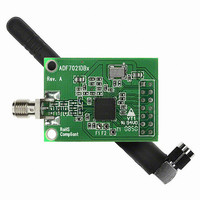EVAL-ADF7021-NDBZ2 Analog Devices Inc, EVAL-ADF7021-NDBZ2 Datasheet - Page 3

EVAL-ADF7021-NDBZ2
Manufacturer Part Number
EVAL-ADF7021-NDBZ2
Description
860 MHz To 870 MHz
Manufacturer
Analog Devices Inc
Type
Transceiver, FSKr
Datasheet
1.ADF7021-NBCPZ-RL.pdf
(64 pages)
Specifications of EVAL-ADF7021-NDBZ2
Frequency
860MHz ~ 870MHz
Lead Free Status / RoHS Status
Lead free / RoHS Compliant
For Use With/related Products
ADF7021-N
Lead Free Status / RoHS Status
Lead free / RoHS Compliant
GENERAL DESCRIPTION
The ADF7021-N is a high performance, low power, narrow-
band transceiver based on the ADF7021. The ADF7021-N has
IF filter bandwidths of 9 kHz, 13.5 kHz, and 18.5 kHz, making
it ideally suited to worldwide narrowband standards and
particularly those that stipulate 12.5 kHz channel separation.
It is designed to operate in the narrow-band, license-free ISM
bands and in the licensed bands with frequency ranges of 80
MHz to 650 MHz and 842 MHz to 916 MHz. The part has both
Gaussian and raised cosine transmit data filtering options to
improve spectral efficiency for narrow-band applications. It is
suitable for circuit applications targeted at the Japanese ARIB
STD-T67, the European ETSI EN 300 220, the Korean short
range device regulations, the Chinese short range device
regulations, and the North American FCC Part 15, Part 90, and
Part 95 regulatory standards. A complete transceiver can be
built using a small number of external discrete components,
making the ADF7021-N very suitable for price-sensitive and
area-sensitive applications.
The range of on-chip FSK modulation and data filtering options
allows users greater flexibility in their choice of modulation
schemes while meeting the tight spectral efficiency requirements.
The ADF7021-N also supports protocols that dynamically
switch among 2FSK, 3FSK, and 4FSK to maximize communica-
tion range and data throughput.
The transmit section contains two voltage controlled oscillators
(VCOs) and a low noise fractional-N PLL with an output
resolution of <1 ppm. The ADF7021-N has a VCO using an
internal LC tank (421 MHz to 458 MHz, 842 MHz to 916 MHz)
and a VCO using an external inductor as part of its tank circuit
(80 MHz to 650 MHz). The dual VCO design allows dual-band
operation where the user can transmit and/or receive at any
frequency supported by the internal inductor VCO and can also
transmit and/or receive at a particular frequency band
supported by the external inductor VCO.
Rev. 0 | Page 3 of 64
The frequency-agile PLL allows the ADF7021-N to be used in
frequency-hopping, spread spectrum (FHSS) systems. Both
VCOs operate at twice the fundamental frequency to reduce
spurious emissions and frequency pulling problems.
The transmitter output power is programmable in 63 steps from
−16 dBm to +13 dBm and has an automatic power ramp control
to prevent spectral splatter and help meet regulatory standards.
The transceiver RF frequency, channel spacing, and modulation
are programmable using a simple 3-wire interface. The device
operates with a power supply range of 2.3 V to 3.6 V and can be
powered down when not in use.
A low IF architecture is used in the receiver (100 kHz), which
minimizes power consumption and the external component
count yet avoids dc offset and flicker noise at low frequencies.
The IF filter has programmable bandwidths of 9 kHz, 13.5 kHz,
and 18.5 kHz. The ADF7021-N supports a wide variety of pro-
grammable features including Rx linearity, sensitivity, and IF
bandwidth, allowing the user to trade off receiver sensitivity
and selectivity against current consumption, depending on the
application. The receiver also features a patent-pending automatic
frequency control (AFC) loop with programmable pull-in range
that allows the PLL to track out the frequency error in the
incoming signal.
The receiver achieves an image rejection performance of 56 dB
using a patent-pending IR calibration scheme that does not
require the use of an external RF source.
An on-chip ADC provides readback of the integrated tempera-
ture sensor, external analog input, battery voltage, and RSSI
signal, which provides savings on an ADC in some applications.
The temperature sensor is accurate to ±10°C over the full oper-
ating temperature range of −40°C to +85°C. This accuracy can
be improved by performing a 1-point calibration at room
temperature and storing the result in memory.
ADF7021-N












